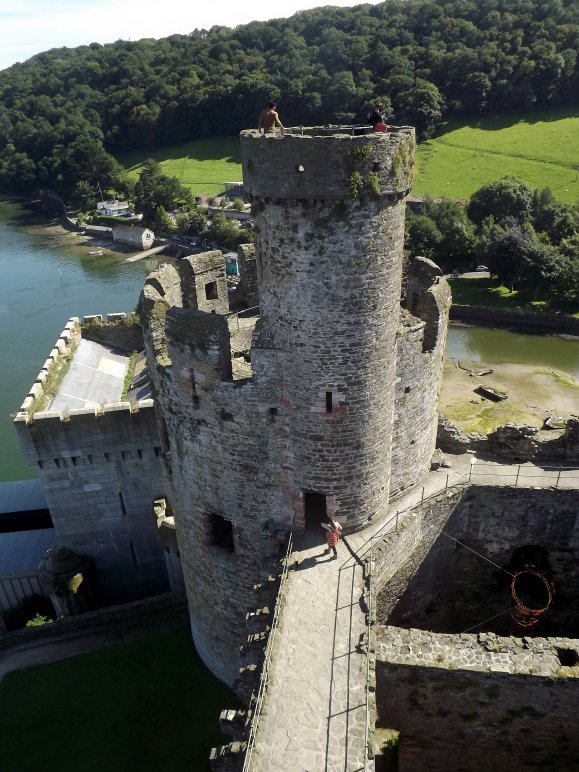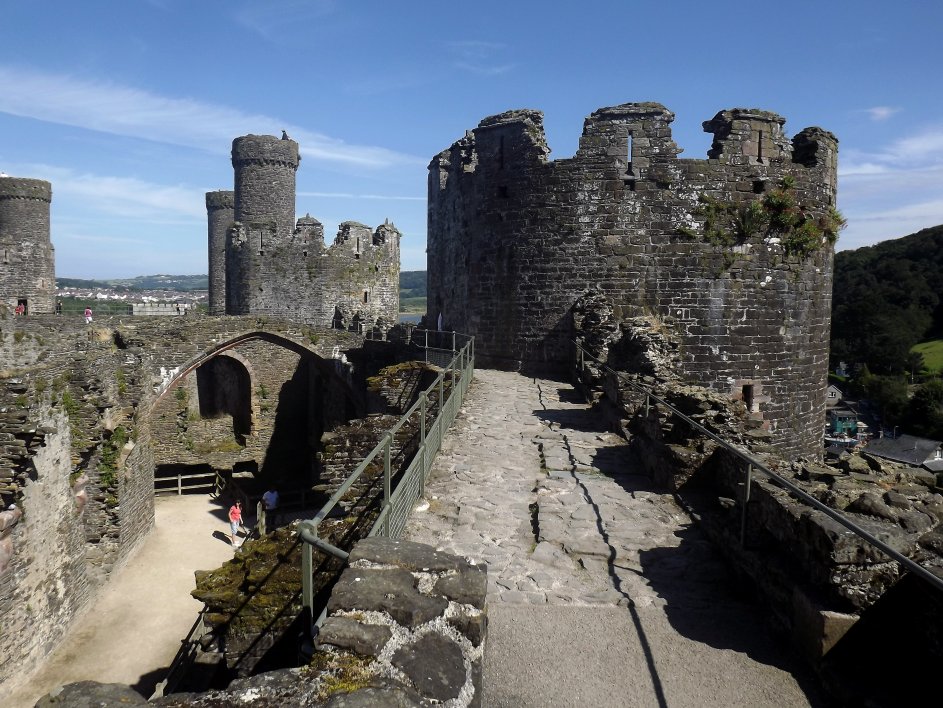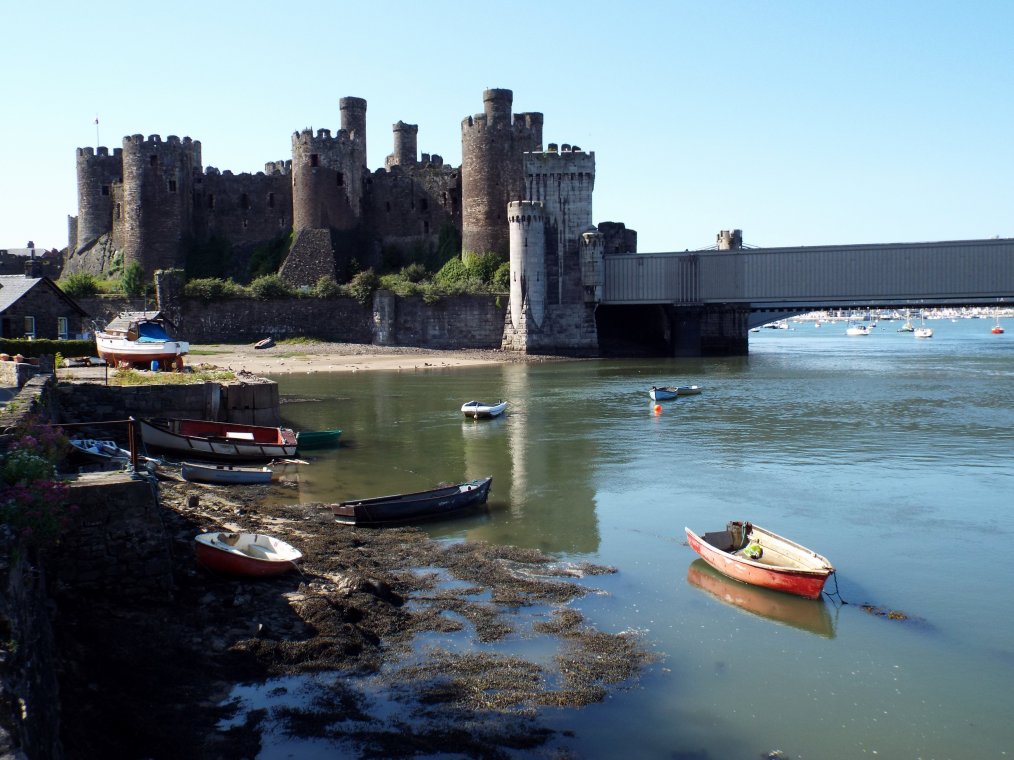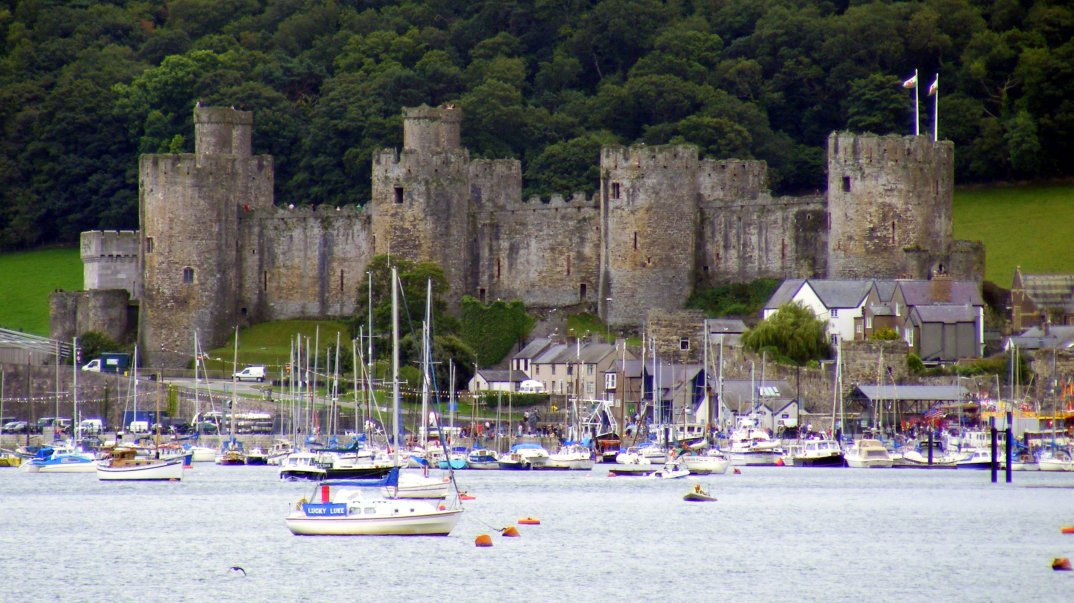Conway Castle
Conway castle stands upon a rock at the confluence of 2
rivers in a position made virtually unassailable by both man and
nature. It replaced an earlier Aberconwy castle which lay some 1,000' to the northeast of the castle main gate and north of Aberconwy abbey. The foundation of the new Conway castle was bound up with the overthrow of Llywelyn ap Gruffydd's principality of Wales.
In 1282 Prince Llywelyn ap Gruffydd was drawn into rebellion against King Edward I (1272-1307). During this war Llywelyn sent armies eastwards at Easter to attack the king's new fortresses of Rhuddlan and Flint. The attacks proved damaging, but failed to storm the fortresses. In the summer King Edward
replied by leading armies up to the River Conway. Here his armies
had to pause as the country behind them was pacified and fresh levies
and stores were brought up for the next step of the campaign. At
this time King Edward camped at the site of Degannwy castle. Then on 11 December 1282, Prince Llywelyn was killed by another cousin, Edmund Mortimer of Wigmore and the next day his army destroyed near Builth Wells.
With Llywelyn dead Edward waited a month to see if the rebels would
surrender, but instead they elevated Llywelyn's brother, Dafydd
(d.1283), to be their prince and continued the struggle. In mid
January 1283, when the land was coated in snow, Edward in person led an
elite striking force across the River Conway to seize Dolwyddelan castle. The fortress surrendered to him on 18 Juanary 1283. Queen Eleanor, waiting at Rhuddlan castle,
was overjoyed by the success of her husband's dangerous snowbound
expedition for which his troops had been kitted out in snow white
uniforms. The main army now crossed over the river to the Welsh
town of Conwy where they occupied Llywelyn's hall and established themselves in the Cistercian Aberconwy abbey. In March and April 1283 many supplies were transported over the river from Degannwy and stored ‘in the abbey'.
 With the king's hold of Gwynedd tightening, King Edward
now began the process of building the new Conway castle that still
dominates the town. The planning for the new castle had begun on
17 March 1283, when Edward ordered Sir Peter Brampton, who had been in
charge of building the earthworks of Flint castle,
to rush 200 woodcutters and 100 diggers to Conway, if necessary paying
for them out of his own pocket. This was followed on 30 March by
William Perton being ordered to buy tools needed to dig the rock cut
ditches around the castle and hire masons, smiths, quarriers and other
workmen for Conway. This seems to have marked the foundation of
the new castle, rather than the repair of Llywelyn's old hall where the king and queen had been staying.
In June 1284, the Keeper of the King's Wardrobe spent 3 days at Conway
surveying the work done and paying the workmen. By October 1284,
the site was sufficiently well advanced for a permanent garrison to be
established. This consisted of 30 fencible men of whom 15 were to
be crossbowmen. The rest were to consist of a chaplain, an
artiller, a carpenter, a mason, a smith and however many janitors and
watchmen as were thought to be necessary. Master James St George
was employed here in his mason's role, but not as some great genius
castle architect as has been often claimed in recent years. Work
continued at the fortress until 1287 by which time some £14,000
had been expended on building the castle and town walls. Smaller
amounts continued to be spent on the fortress thereafter and in 1305 a
murage was granted to the town for 7 years. Indeed, the work
never quite seems to have been finished for as late as 1343 there were
complaints that the tower near the postern had not been finished and
that this compromised the safety of the town garrison.
With the king's hold of Gwynedd tightening, King Edward
now began the process of building the new Conway castle that still
dominates the town. The planning for the new castle had begun on
17 March 1283, when Edward ordered Sir Peter Brampton, who had been in
charge of building the earthworks of Flint castle,
to rush 200 woodcutters and 100 diggers to Conway, if necessary paying
for them out of his own pocket. This was followed on 30 March by
William Perton being ordered to buy tools needed to dig the rock cut
ditches around the castle and hire masons, smiths, quarriers and other
workmen for Conway. This seems to have marked the foundation of
the new castle, rather than the repair of Llywelyn's old hall where the king and queen had been staying.
In June 1284, the Keeper of the King's Wardrobe spent 3 days at Conway
surveying the work done and paying the workmen. By October 1284,
the site was sufficiently well advanced for a permanent garrison to be
established. This consisted of 30 fencible men of whom 15 were to
be crossbowmen. The rest were to consist of a chaplain, an
artiller, a carpenter, a mason, a smith and however many janitors and
watchmen as were thought to be necessary. Master James St George
was employed here in his mason's role, but not as some great genius
castle architect as has been often claimed in recent years. Work
continued at the fortress until 1287 by which time some £14,000
had been expended on building the castle and town walls. Smaller
amounts continued to be spent on the fortress thereafter and in 1305 a
murage was granted to the town for 7 years. Indeed, the work
never quite seems to have been finished for as late as 1343 there were
complaints that the tower near the postern had not been finished and
that this compromised the safety of the town garrison.
After thinking Wales pacified, King Edward
(1272-1307) received a rude shock when Wales rebelled when he asked the
Welsh to help him fight the French in 1294. That winter he led an
army of 5,000 foot to reconquer Denbigh and Ruthin and confer with his Welsh allies. However, after pushing on as far as Nefyn beyond Caernarfon, he was forced to shelter within Conway's powerful walls in December, cut off from his other force of 10,000 men stationed at Rhuddlan. The contemporary Worcester chronicle recorded:
The king spent Christmas with
his men at Conway, where the queen of Navarre came to him... while the
army remained at Conway lamenting the great loss through delay, there
came to him on 9 March all of the archers and crossbowmen; they asked
his licence to go out against their enemies, and this he allowed.
At length he sent them with his chosen knights. And they came
upon his enemies while they were lying in their beds. They rushed
upon them, decapitating them and impaling their heads on their lances
to the number of 500 and with them they found all the plate and
necessities dishonourably taken by them some time ago.
While the slightly later Walter Hemingburgh declared:
So the king, having crossed
the River Conway, retreated with part of his army to the castle, where
he was for some time besieged by the Welsh as well as by the
overflowing waters of the sea and sudden waves. Thus separated
and excluded from his own people, he suffered for a short time both
hunger and thirst, and drank water mixed with honey, and could not eat
bread to his fill; for the Welsh had overtaken the supply teams, and
took and carried away their provisions, cutting down the men whom they
caught. And while they had a little wine, two casks of one
gallon, which they had decided to save for the king, the king himself
did not consent, but said, "In necessity all things must be in common
and we shall all suffer one and the same diet until God himself looks
down upon us from on high; so let me not take preference over you in
eating, as I am the origin and cause of this constraint." Soon
afterwards Almighty God visited them, and as the waters receded, the
whole army came to the king, and the Welsh themselves were put to
flight.
On 5 March 1295, the main rebellion under Prince Madog ap Llywelyn was defeated by the army of Montgomery.
Edward around this time emerged from his grim fortress to accept the
surrender of all the rebels as he progressed through Wales that summer.
For all the hard work in building the castle and the fact that Edward
wintered there in 1294/95, it rather turned out to be a white elephant
and was soon allowed to fall into disrepair. In 1322 it was
reported, like many of its contemporaries, to be unfit to accommodate
the king, while by 1343 it was so derelict that the great hall could
not be repaired for less than £160, while 6 of the 8 towers were
derelict and the roofs and floors within them could not be put right
for less than £131. In 1347 the roof of the great hall was
replaced with the great stone trusses which can still be seen.
The new roof they built survived until the sixteenth century. The
rest of the castle was also repaired at this time.

In 1399 King Richard II
(1377-99) tarried briefly here on his way back from Ireland while he
negotiated with the archbishop of Canterbury on behalf of the rebel
Henry Bolingbroke who then usurped the throne as Henry IV
(1399-1413). So it was here at Conway castle that the king
effectively signed his own death warrant by agreeing to march to Flint castle
where he would surrender to his enemies. However, the castle's
main claim to latter fame occurred on Good Friday, 1 April 1401.
On that day 40 men of William and Rhys ap Tewdwr, the great granduncles
of the future King Henry VII (1485-1509), entered the town by
pretending to be workmen. They then quickly killed the gatehouse
guards and seized the castle while the garrison was at prayer.
The famous Harry Hotspur (d.1403) was at the time absentee constable of
the castle and he with Prince Hal, later to be the famous Henry V of
Agincourt fame, hurriedly rushed 120 men at arms and 300 archers to
besiege the castle. This eventually resulted in the return of the
castle to royal control by 8 July 1401 when the government sent a:
Pardon at their supplication
to William ap Tewdwr (d.1413+) and Rhys ap Tewdwr (d.1412) his brother,
of North Wales and their accomplices, who lately rose in insurrection
and took Coneweye castle in North Wales and burned the town of Coneweye and despoiled the burgesses.
Interestingly, this revolt had nothing to do with the much more famous revolt of Owain Glyndwr.
Conway again saw military action during the English Civil War when
Archbishop John Williams held the castle for King Charles I
(1625-49). On 9 May 1645, Sir John Owen (d.1666), the royalist
captain of Conway town:
about 7 O'clock in the
evening... did with bars of iron and armed men, break the locks and
doors and enter into the said castle and seize upon the place the
victuals, powder, arms and ammunition.
They then expelled the archbishop accusing him of treason. After Sir John ransacked Gwydir castle,
the archbishop did change sides and led the Parliamentarians to Conway.
He then led his 60 men in the great Parliamentarian attack upon
the town where he sustained a wound in the neck. At the year's
beginning the town and castle had been garrisoned by some 590 men,
although how many remained 18 months later is open to question.
On 9 August 1646, General Mytton stormed Conway town wall with 30' high
ladders, which proved 4' too short for the job. This resulted in
some acrobatics to get their forces over the battlements.
According to Mytton some of his men:
were knocked down and crushed
by horses, others cast off ladders... till a considerable company were
got over, which being done they fell into the town, surprised the main
guard, killed a corporal and a gentleman there, wounded many, took a
major, an old cowdriver, 4 lieutenants, 4 ensigns, 22 soldiers of
fortune and 50 townsmen in arms. Many Irish were commanded to be
tied back to back and cast overboard and sent by water to their own
country...

The castle and town walls remained virtually intact after its remaining
iron and lead were sold off in 1665 and from the late eighteenth
century it began to attract the interest of topographical artists and
tourists. One result of this was for the town council to order
the removal of all the spiral stairs in the towers to discourage
visitors!
Description
Conway castle was designed as two adjoining wards with eight powerful
towers that could all be defended individually in case one or more fell
to attackers. In effect these were two independent castles, both
entered from either end and joined by a central crosswall with its own
gatehouse and ditch. The 4 towers that surrounded the inner ward
were designed to carry turrets and so were visually the most impressive
of the 8. The northeast tower still contains the fine thirteenth
century chapel. The tower has recently been refloored and
roofed. The wallwalks allowed access throughout the castle, but
access to the inner ward at this level was blocked by doors in narrow
passageways around the 2 westernmost towers of the east ward. As
the heart of the castle this inner ward contained the royal apartments
which still survive intact other than their floors and roofs. To
the east the ward was entered from a small barbican overlooking the
River Conway. This gave access to a small harbour through which
the castle could be resupplied by sea.
The outer ward to the west was much larger than the inner ward.
Along it's south wall was the peculiarly shaped great hall which
was some 125' long. The western ward also had 4 towers, 2 at the
eastern angles and 2 more half way along the north and south
curtains. It was entered through a powerful barbican which was
reached via a 125' long ramp running up from the town and passing over
the great ditch dug for Edward I in 1283. The main gate was
simply a hole in the wall affair, but it and the surrounding curtain
were further protected by a fine set of machicolations.
The town walls of Conway, built at the same time as King Edward's
castle, are similarly intact apart from the tower floors and
roofs. Twenty of the 21 D shaped towers survive. There are
also 3 powerful twin towered gatehouses set to east, west and south.
To the north is the great round tower set upon the highest point
of the enceinte.
Set centrally in the town is the parish church built into the remains of the 1186 Aberconwy abbey
and a short distance away from that stands Plas Mawr, the family home
of Archbishop Williams, while at the crossroads by the south town gate
stands a semi timbered house thought until recently to be Tudor.
However dendrochronological dating has shown this to date back to the
time when Edward I through his forceful personality stamped the shape of modern Conway.
Why not join me at Conway and other British castles this October? Please see the information on tours at Scholarly Sojourns.
Copyright©2016
Paul Martin Remfry


 With the king's hold of Gwynedd tightening, King Edward
now began the process of building the new Conway castle that still
dominates the town. The planning for the new castle had begun on
17 March 1283, when Edward ordered Sir Peter Brampton, who had been in
charge of building the earthworks of Flint castle,
to rush 200 woodcutters and 100 diggers to Conway, if necessary paying
for them out of his own pocket. This was followed on 30 March by
William Perton being ordered to buy tools needed to dig the rock cut
ditches around the castle and hire masons, smiths, quarriers and other
workmen for Conway. This seems to have marked the foundation of
the new castle, rather than the repair of Llywelyn's old hall where the king and queen had been staying.
In June 1284, the Keeper of the King's Wardrobe spent 3 days at Conway
surveying the work done and paying the workmen. By October 1284,
the site was sufficiently well advanced for a permanent garrison to be
established. This consisted of 30 fencible men of whom 15 were to
be crossbowmen. The rest were to consist of a chaplain, an
artiller, a carpenter, a mason, a smith and however many janitors and
watchmen as were thought to be necessary. Master James St George
was employed here in his mason's role, but not as some great genius
castle architect as has been often claimed in recent years. Work
continued at the fortress until 1287 by which time some £14,000
had been expended on building the castle and town walls. Smaller
amounts continued to be spent on the fortress thereafter and in 1305 a
murage was granted to the town for 7 years. Indeed, the work
never quite seems to have been finished for as late as 1343 there were
complaints that the tower near the postern had not been finished and
that this compromised the safety of the town garrison.
With the king's hold of Gwynedd tightening, King Edward
now began the process of building the new Conway castle that still
dominates the town. The planning for the new castle had begun on
17 March 1283, when Edward ordered Sir Peter Brampton, who had been in
charge of building the earthworks of Flint castle,
to rush 200 woodcutters and 100 diggers to Conway, if necessary paying
for them out of his own pocket. This was followed on 30 March by
William Perton being ordered to buy tools needed to dig the rock cut
ditches around the castle and hire masons, smiths, quarriers and other
workmen for Conway. This seems to have marked the foundation of
the new castle, rather than the repair of Llywelyn's old hall where the king and queen had been staying.
In June 1284, the Keeper of the King's Wardrobe spent 3 days at Conway
surveying the work done and paying the workmen. By October 1284,
the site was sufficiently well advanced for a permanent garrison to be
established. This consisted of 30 fencible men of whom 15 were to
be crossbowmen. The rest were to consist of a chaplain, an
artiller, a carpenter, a mason, a smith and however many janitors and
watchmen as were thought to be necessary. Master James St George
was employed here in his mason's role, but not as some great genius
castle architect as has been often claimed in recent years. Work
continued at the fortress until 1287 by which time some £14,000
had been expended on building the castle and town walls. Smaller
amounts continued to be spent on the fortress thereafter and in 1305 a
murage was granted to the town for 7 years. Indeed, the work
never quite seems to have been finished for as late as 1343 there were
complaints that the tower near the postern had not been finished and
that this compromised the safety of the town garrison.
